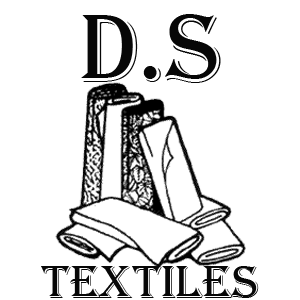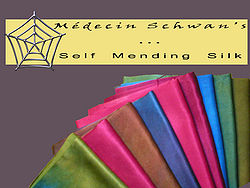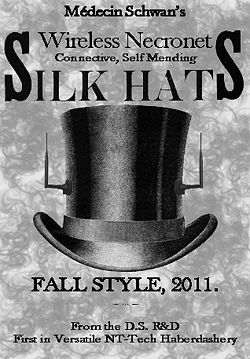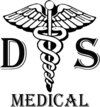|

During a particularly violent time in the history of the D.S. R&D, the group came under fire by an organization called the Heathers. This group, composed of narcissistic, fashion-crazed women and their indentured manslaves, set Dr. Schwan to thinking that perhaps there was another way in which he could improve the quality of life for those within the Malton quarantine zone. He began to look at those around him, seeing a cornucopia of tattered and bloodstained cloth. He reasoned to himself “these survivors have been living in Malton for years, and surprisingly, their number has only grown. The supply drops include necessities but not very many luxury items like clothing. The malls, being the largest repository of goods (including clothing), have become such a popular target for the zombie hoards that none have escaped being ransacked. Add to this the bits of folk wisdom by which we live including ‘dress for success’ and ‘every girl’s crazy bout a sharp dressed man,’ it stands to reason that the demand for quality clothing must greatly exceed the present supply. Perhaps there is a way to rectify this issue…through science”
Excited at having identified a problem, he turned his attention to the resolution. “But what do people wear?” He looked around, noticing a mix-mash of trench coats, T-shirts, practical clothing, and costumes, and quickly decided that there was no unifying sense of style in Malton. The answer then must lie not in the production of clothing but in the production of quality textiles out of which people may make or have made their own clothing.
With no local livestock or cotton crop, the problem of designing such fabrics at first appeared daunting. Dr. Schwan briefly considered the idea of using products derived from discarded zombie material but decided that such fabric would be little better than bloodstained cloth. More ingenuity would be required. The result…a new line of products from Colglough industries…Les Produits du Textile de Médecin Schwan
Current Product Line
Médecin Schwan’s Self Mending Silk
The first product in the textile line, Médecin Schwan’s Self Mending Silk is a marvel of cutting edge rot science at work.
As he set out to introduce quality textiles to Malton, Dr. Schwan was puzzled as to where to begin: while leather is practical, its relative durability makes it still somewhat obtainable. Cotton, as a plant product, presented other difficulties. These thoughts and others crossed his mind as he lay prone on the street in Woolley Grove waiting for the revivification serum to finish repairing his broken body. He was continuing in this vein, sensation slowly returning to his body, when—conscious though unable to blink due to the residual influence of his patented optical paralytic—he became distracted by the presence of an uninvited guest. A spider, who had just climbed from the mouth of a nearby corpse, had made its way to Dr. Schwan and begun to build a web from his eyelashes to the ground. He compartmentalized the nettling itch of the spider’s legs to a different portion of his brain and observed.
As the spider spun, the Dr. observed certain peculiarities in the design of its web. The newly made web seemed damaged: places that should be connected into an organized repeating pattern loosely governed by Fibonacci‘s sequence, were left empty. As the Dr. continued to watch, he observed one of the many flies that inhabit revive points fly dangerously close to the web, swerve directly into it, pass through a gap in the web design and fly off uninjured. This event did not seem to perturb the spider at all. Curious. He continued to watch as the spider finished the web, adding strange secretions along it that appeared to mimic the effect of dust and decay. Its work complete, the spider retreated behind the doctor’s left ear.
Little time had passed before another spider happened by and spotted the web. Taking it for abandoned, the second spider advanced towards the doctor’s still open eye to examine the find, but no sooner had it set foot on the curious web, than it was stuck fast to the dust-like secretion. There was movement behind Dr. Schwan’s ear and the first spider was upon its snared victim, ripping it from the web and consuming its head and abdomen. In the place where the second arachnid had been, the web began to mend itself. The Dr. blinked in amazement, suddenly realizing that he had been able to move for some time and was merely transfixed with fascination. This action collapsed the web on top of the first spider. As it struggled, Dr. Schwan scooped it up in his hand and dropped it into one of the many sample jars he carries on his person.
Studying it later, using what equipment he could scavenge while hiding in the ruins of Colglough, the Dr. confirmed his original suspicion: the spider was indeed infected with the rot virus. Further study revealed that the web coating contained elements of the same digestive enzyme the zombies use to regenerate wounds by feeding on corpses, explaining the web’s regenerative properties.
To make a long story short, 15,000 infected spiders, three chemical treatments, one fully automated subterranean spinning facility, and a series of chemical dye applications later, and the first bolt of Médecin Schwan’s Self Mending Silk rolled off the loom.
This fabric, available in every color of the litmus paper ph reaction spectrum, can be made into shirts, dresses, or undergarments. Exposure to blood causes each strand of the fabric to mend itself making sure that, though your body may be battered, your pride may remain intact. (warning: do not let fabric bunch during exposure to blood as bonding between layers will occur)
To order and use Médecin Schwan’s Self Mending Silk simply copy the code for the following tag to your user page

|
D.S. Textiles
|
| This user’s dignity is safeguarded even in extreme circumstances thanks to Médecin Schwan’s Self Mending Silk.
|
Wireless Necronet Connective Self Mending Silk Hats
(A.K.A. Thinking caps)
Green LEDs flash along the side of this stylish tophat as it connects to the wireless NecroNet. The numerous electrodes woven into the stain resistant lining tingle slightly as they filter out ambient electromagnetic interference, detect brainwaves, and connect to the cortex. Made of SchwanTech’s patented Self-Repairing Silk.
To order and use Schwan's Wireless Necronet Connective Self Mending Silk Hats simply copy the code for the following tag to your user page

|
D.S. Textiles
|
| This user knows how to stay connected by using Schwan's Wireless Necronet Connective Self Mending Silk Hats
|
Schwan Brand Rot-Cotton
|
|

|
| Survivor Application
|
It was April and the dead had risen one more. What had started as a trickling increase in numbers had become a foudroyant tidal wave that swept across the city leaving only ruination in its wake. As the larger groups of survivors moved to the East to defend what remained of their city, Dr. Schwan and his team of researches moved to the west to see of what use they could be in the reconstruction effort. With this purpose in mind, Albert found himself in New Arkham, screwdriver and NT syringe both at the ready, going over suburb restoration plans with Scouteric of the Wulves.
Albert had not visited New Arkham in almost a year but the area was still very familiar to him. The meadows to the West that stretched into what had once been old Dunwitch and the time honored halls of Miskatonic to the East still held the same majestic grandeur they had when he was a student here so many years ago. Many of the older buildings which frightened the superstitious locals so looked the same as he remembered them despite the ruination brought on by the recent zombie march.
|
|

|
| Zombie Application
|
Brought around by the voice of his ally, Albert turned himself from his idle reminiscences to the task at hand. Scouteric was explaining how the largest problem facing their work in the suburb was the overall generic quality of the zombies they encountered on the street. In a suburb long since accustomed to the walking dead, Arkham zombies possessed a certain homogeneity, effected by a similar stricken expression, that made it difficult to tell which ones had been the victims and which the victimizers. Add to that the prevalence of advanced cerebral degeneration and the unnatural parlor of even the living inhabitants of this area and the revivification effort became a much more complicated undertaking. Nearby, Bubert—one of the youngest of Dr. Schwan’s team—chuckled at the ironic use of the word “undertaking” as he cleaned the complicated make-shift Necronet connectors on a portable generator. Deciding to ere on the side of excess, Albert and those assembled resolved to revivify any they could, settling on the Western Mitchner Building for their next target.
A new day dawned and saw them standing outside Mitchner, a small yellow-stone building whose facade was beginning to crumble. The doors hung open at uneven angles and through the windows they could see that the building had been ruined for some time. As they approached, a low moaning emanated from within. Albert primed his syringes as he advanced quietly through the front door while his wife Solo headed around back, pulling a furniture dolly on which rested the portable generator. Crouched in the entry way, he waited.
Soon enough, there was a series of popping noises as the electricity coursed through the building and encountered clusters of missing or damaged wires. The main conduits, well shielded in the structure of the building itself, coursed with new life and lit the terminals, what emergency lights had not been shattered, and the Necrotech logo which glowed gently above the front desk. Albert dared to take a moment to marvel at the vanity required to include these corporate logos on the same circuits that powered the emergency functions, before rushing into the room and plunging his syringe into the neck of the first zombie he encountered.
|
|

|
| Mega-horde Application
|
Within the building they encountered only 5 other zombies whom they subdued and treated following prescribed Necrotech procedures. Albert and Solo dragged out the bodies, which were now twitching in rhythm with the slow molecular work of the NT solution, while Scouteric began repairs and moved barricades into place.
The building was a mess: lab benches and tables had been overturned, smears of blood covered the floor, and vines had begun to creep up the inside of the walls. Over all was a thick layer of dust and debris spotted with the occasional black lichen or fungus. Dr. Schwan recognized this vegetation as the same that grows in all corners of Malton and serves as an indicator of how long a building has remained in the hold of the undead. Though he had long thought it peculiar, he had never had occasion to study it as more pressing matters had always diverted him from such a pursuit. So was it now as he took screwdriver in hand and set about replacing some of the faulty wiring.
Standing on a stepladder Albert reached for area near the top of the lobby wall when the debris under the ladder’s foot settled, causing him to have to clutch at the wall to keep his balance. In an effort to catch himself, he brushed his arm against one of the putrescent clusters when he was amazed to see it move slightly and change color at the sight of contact from black to light blue. This unexpected development so surprised Dr. Schwan that he again lost his footing a fell from the ladder and came crashing to the ground in a rain of tools, plaster, and the mysterious plant.
When Albert regained consciousness, he collected as many samples as he could to analyze once the labs had been restored.
Further analysis revealed that the substance was a variety of the fungus Roccella Tinctoria—the same fungus used in the creation of litmus paper—that has mutated as a result of prolonged exposure to the rot virus. A powder of the fungus displayed curious proprerties: when brought in contact with ordinary living cells, it retained its light blue color, but when exposed to dead cells contaminated by the rot virus, it became jet black. Through a series of trials which resulting in the dicoloration of a great many zombies and researchers, Dr. Schwan was able to fashion the powder into a dye that retained these properties and use it to stain cotton. The resultant fabric can be cut, sewn, and silk screened to produce apparel that will react with bodily fluids like blood or perspiration to indicate the current state of the wearer. Mixed with a red dye, it is able to produce the colors purple and brown, while mixed with a yellow dye, it is able to produce green and tan.
Though the fabric does have a tendency to cause infection-like symptoms in some customers and severe rashes in others, these side effects are only experienced by 30-40% of people and can be treated with micro injections of NT solution at the affected areas. Dr. Schwan maintains that the advantages to be gained by color coding the living and the dead far outweigh the cost.
To order and use Schwan Brand Rot-Cotton T-shirts simply copy the code for the following tag to your user page

|
D.S. Textiles
|
| This user keeps it casual with Schwan Brand Rot-Cotton T-shirts
|
Custom Mask Line
Made of Schwan brand Bioply Ceramic!
Many months had come and gone and changed the face of Malton. After the dead came the snows, and after that , a blighted renaissance. The forbidden science of cloning a fully functioning individual, once only practiced in dark recesses by a vulgar elite, had spread its corrupt wings to envelope the city. Streets and buildings were full of beings more drone than human bearing designations where they should bear names. The already complex definition of "life" in Malton was changing. Was this what science had become? Albert Schwan could not believe it!
He had taken a life, having killed Dr Munoz quite by accident while defending the retirement part of his friend Josh Clark from an attack by the Heathers. As the body hit the floor, Albert recalled that he had been intrigued by the sensation that it had stirred within him. It was not rage, nor was it pleasure or regret: rather it was a cool curiosity. Was he a murderer? Did this being, who had been cloned form the cells of a long dead scientist combined with the cells of one of the Heather brood mothers, possess an animus of its own or was it more like a limb, acting in concert with other beings under a singular directing will? Was he a murderer or a surgeon. Surely experimentation would hold the answer. This was a job...for science!
In the weeks that followed, Albert tracked the Heathers back to their nests and experimented on them, testing for durability, regeneration, flammability, absorbency, and many other traits. Ultimately, he was able to discern their nature. The cloning process was crude yet ingenious in its own way. The beings were linked to a hive mind of sorts that had no central point of command yet spread it's influence through each being who shared the genetic line. Upon the death of an individual member, the hive rerouted consciousness to the nearest alternate member, overriding its current objective and using it to repair the fallen drone or adopt its mission. Further testing concluded that many such hives existed in Malton, connected to each member of the group yet disconnected from every other hive, the increase in distinct hives being responsible for the current state of Malton. But where did it start and how if it all can it be curtailed? If the answers were to be found anywhere, surely they must lie within the arcane and scientific collection held the lauded Miskatonic Library. Albert resolved to return to his old Alma Mater and continue his research.
When he arrived some days later, he was shocked to see the campus in ruins: the campus buildings ransacked, the historic townhouses devoid of life, the ever-vigilant statues that once lined the campus courtyard falling derelict of their duty as they lay smashed on the ground. Albert was became aware that he would have shed a tear at the sight were it not for the emotion suppressing drugs he habitually ingested to maintain his scientific focus. He made note of the sensation in the notebook he keeps ever with him and resolved to interrogate it later. For now, he had to find if aught of the resources of MU remained intact.
Hours of searching became days as it became more and more clear that if the answers to Dr. Schwan's questions were here, they were buried beneath more debris than one man could shift. As he sat atop a pile of rubble in the rare books section of the library, Albert was interrupted by a familiar "THOOP" sound as a message in a plastic cylindrical container emerged from a conduit linking to Malton's subterranean pneumatic communications network. He seized the container and ran his hand over one end. It read his bio-signature and opened to reveal a note.
It was a message that had been relayed through a contact from the Philosophe Knights requesting a compound to increase the durability of their iconic masks. Dr. Schwan had heard of the PK and met a few of their members over the years but their violent methodology had prevented him from interacting with them much. Usually a pacifist, Albert had respected their purpose but thought it best to avoid them. However, recent events had blurred the ethical line and made their actions much more difficult to condemn. Given the complication of life and death in Malton, was it really so hard to see immortality as a pedagogical tool? At the very least, reasoned Dr. Schwan, some old fashion R&D should be a much needed diversion from the bleakness of the task at hand. He commandeered a lab, trapped and sedated some raw materials on the street, and set to work.
After a few faltering attempts at creating the desired compound from different ceramics and biological enamels, the closest Albert had managed was a substance that jellified plaster. Eventually he scrapped the idea of a coating in favor of a completely new mask material. Soon into this process, he scrapped the idea of product that cannot break or tarnish and began investigating substances that can regenerate to repair damage and restore sheen.
Using the resources of the MU campus, he modified the fibroblasts responsible for forming connective tissue from a zombie to build said tissue using modified elastic filamentous hyphae of a massive soil fungus. Typically, such a fungus is capable of growing almost a mile worth of fungal filaments in a single day; the variety found in the MU cemetery, which had been modified by years of exposure to arcane forces, revivified flesh, and other experimental chemicals, proved much more lively. Binding it to a ground substance of NT solution and blood serum, Albert was finally able to create a pliant and instantly regenerative material. After only losing three labs to the uncontrollable expansion of the material, Albert developed a method whereby the edges and faces can be cauterized to bind it to a specific size and shape. Using this new material as a core, Albert repeated the process, replacing the fungal fiber with Kelp fiber, to create a similar sheet of material that, while less regenerative, was more flexible and sealed more cleanly. Finally, he repeated the process once more using modified bamboo fibers from a local decorative bamboo that has been known to grow up to 12 inches in a day, and replacing the fibroblasts with zombie osteoblasts for a woven bone finish, deciding on woven bone vs lamellar for quicker growing at the expense of strength. Layering these three sheets together like plywood and pressing them into a mask using heat, Albert created the first mask. Using elements of the hive technology he had been studying, he linked the three sheets together by their shared genetic line that they might function as a single material. After that, reproduction was absurdly simple as the material, if left untreated along a single edge, replicates itself rapidly and needs only to be heat-pressed into shape.
The resulting mask was truly a work of art. The core repairs almost instantly when damaged if supplied with nutrient. The bleeding that usually accompanies said damage takes care of this requirement. The kelp backing is the most pliable layer and keeps the structure together. After damage is sustained, the surface layer takes about a day to mineralize fully, but the resulting imperfection is invisible except on close examination. The hive technology allows the layers to coordinate repairs and regenerate correctly should the mask sustain simultaneous damage in multiple areas. The cells retain a useful quality of the plants from which they were derived in that the surface cleans itself by metabolizing anything on it, leaving only unusable elements like silica on the face of the mask which powder and fall from the product. The rot virus allows it to metabolize a wide variety of substances to a limited degree so the only time that the surface should retain material is when the mask has no need of nutrients. The mask is a living organism and thus it must be "fed" regularly with blood or NT solution or else it "dies" and becomes brittle.
One final side effect of the material is that the heat binding becomes somewhat unstable during the regenerative process. On the surface layer, this will result in a slight texturing over time. On the backing layer, the mask may bond to a slight degree to the face as it absorbs and converts the blood. An antibiotic felt backing is therefore recommended, which will need to be replaced from time to time as damage occurs. Without it, the mask will in time bond completely to the face and become irremovable.
Content with the end result, Albert packaged the first order for shipment and shipped it to the most ignorant group he could think of who resided in North and South Blythville. Doing so, he was satisfied, would ensure that it fell into the hands of the Knights eventually.
To order and use Schwan brand Bioply Ceramic Masks simply copy the code for the following tag to your user page

|
D.S. Textiles
|
| This user’s identity is protected by Schwan brand Bioply Ceramic.
|
Other Products and Services
|

















